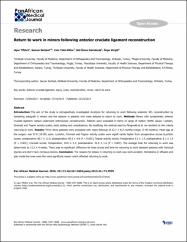| dc.contributor.author | Tiftikci, Uğur | |
| dc.contributor.author | Serbest, Sancar | |
| dc.contributor.author | Kılınç, Cem Yalın | |
| dc.contributor.author | Karabıçak, Gül Öznur | |
| dc.contributor.author | Vergili, Özge | |
| dc.date.accessioned | 2020-11-20T15:04:35Z | |
| dc.date.available | 2020-11-20T15:04:35Z | |
| dc.date.issued | 2015 | |
| dc.identifier.issn | 1937-8688 | |
| dc.identifier.uri | https://doi.org/10.11604/pamj.2015.22.173.7979 | |
| dc.identifier.uri | https://hdl.handle.net/20.500.12809/2901 | |
| dc.description | WOS: 000376790800001 | en_US |
| dc.description | PubMed ID: 26918069 | en_US |
| dc.description.abstract | Introduction: The aim of the study is retrospectively investigated durations for returning to work following anatomic ACL reconstruction by hamstring autograft in miners and the reasons in patients who were delayed to return to work. Methods: Miners with symptomatic anterior cruciate ligament rupture underwent arthroscopic reconstruction. Patients were evaluated in terms of range of motion (ROM) values; Lysholm, Cincinati and Tegner activity scales; laxity testing and complications. By modifying the method used by Fitzgerald et al. we decided for the criteria returning to work. Results: Thirty three patients were evaluated with mean followup of 22.7 +/- 8.3 months (range 13-46 months). Mean age at the surgery was 27.8 (18-38) years. Lysholm, Cincinati and Tegner activity scales were signifi cantly higher from preoperative scores (Lysholm scores: preoperative: 60.7 +/- 12.5, postoperative: 90.3 +/- 4.8 (P < 0.001); Tegner activity scores: Preoperative 3.5 +/- 1.4, postoperative: 6.2 +/- 1.5 (P < 0.001); Cincinati scores: Preoperative: 14.8 +/- 5.3, postoperative: 26.9 +/- 1.6 (P < 0.001). The average time for returning to work was determined as 15,3 +/- 4 weeks. There was no significant difference for knee scores and time for returning to work between patients with meniscal injuries and don't have meniscus lesions. Conclusion: The reasons for delays in returning to work was work accident. Hematoma or effusion and pain inside the knee were the most significant reason which affected returning to work. | en_US |
| dc.item-language.iso | eng | en_US |
| dc.publisher | African Field Epidemiology Network-Afenet | en_US |
| dc.item-rights | info:eu-repo/semantics/openAccess | en_US |
| dc.subject | Anterior Cruciate Ligament | en_US |
| dc.subject | Injury | en_US |
| dc.subject | Knee | en_US |
| dc.subject | Reconstruction | en_US |
| dc.subject | Miner | en_US |
| dc.subject | Return To Work | en_US |
| dc.title | Return to work in miners following anterior cruciate ligament reconstruction | en_US |
| dc.item-type | article | en_US |
| dc.contributor.department | MÜ, Tıp Fakültesi, Cerrahi Tıp Bilimleri Bölümü | en_US |
| dc.contributor.institutionauthor | Kılınç, Cem Yalın | |
| dc.identifier.doi | 10.11604/pamj.2015.22.173.7979 | |
| dc.identifier.volume | 22 | en_US |
| dc.relation.journal | Pan African Medical Journal | en_US |
| dc.relation.publicationcategory | Makale - Uluslararası Hakemli Dergi - Kurum Öğretim Elemanı | en_US |


















